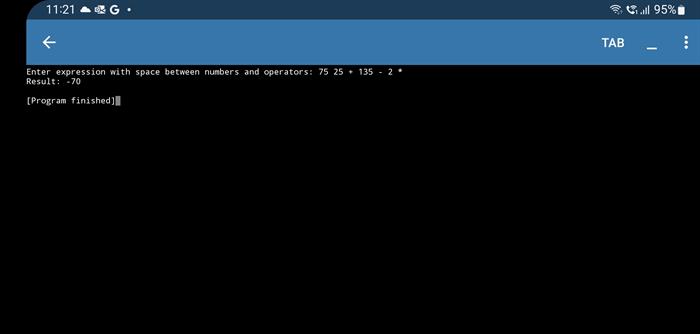This article is the demonstration of a stack based RPN calculator. In this article, first we will look at how to create a stack class with the basic push and pop operations and then we will see how this stack class can be used to evaluate postfix expressions.
Introduction
Through this article, I wish to demonstrate creating a Reverse Polish Notation (RPN) Calculator which can be used to evaluate postfix expressions. In a postfix operation, an operator appears after its operands. For example, an infix expression like 25 + 12 would be written as 25 12 + in the postfix notation. A postfix expression is evaluated in the order in which the operations appear (left to right).
For this, we need to define a stack class. This stack class will be the container for the operands as well as intermediate results. The final result also gets stored in the stack and is extracted at the end of the process and displayed.
Background
RPN Calculator, also known as Stack Calculator, is a special type of calculator in which there must be two operands before an operator in an expression. The RPN calculator works by pushing operands into a stack until an operator is encountered. When an operator is encountered, the last two pushed operands are popped, the required operation is performed, and the result of the operation is again pushed into the stack. At the end of the expression, the last value is popped from the stack and displayed as the final result.
Using the Code
Following is the code for the Node class which is the building block for our Stack class. It defines a constructor and the required getter and setter methods.
class Node:
def __init__(self,d):
self.data = d
def setnext(self,n):
self.next = n
def getdata(self):
return self.data
def getnext(self):
return self.next
Following is the code for the Stack class. It defines a constructor and the push and pop operations in addition to a method to check if the stack is empty.
class Stack:
def __init__(self):
self.top = None
def push(self,d):
self.newnode = Node(d)
self.newnode.setnext(self.top)
self.top = self.newnode
def pop(self):
temp = self.top
self.top = self.top.getnext()
n = temp.getdata()
del temp
return n
def isempty(self):
return self.top == None
Following is the code for the main program. The main program involves accepting input from the user and performing the calculations by using the functions of our stack class. The expression entered to be evaluated must have a space between two operands as well as between an operand and operator, for example, 78 100 + 200 - 5 *
IMPORTANT: If at least one space is not used between elements of the expression, you may get unexpected results.
The code uses the sub() function of the regular expression module (re) to subsitute multiple spaces in the postfix expression with one space and the split() function to parse the expression and extract the elements of the expression (operators and operands) into a list. The strip() function is used to remove the leading and trailing spaces. It pushes the operands into the stack and pops the last two operands and pushes their result when an operator is encountered. At the end, it pops and displays the value from the stack as the final result.
import re
if __name__ == "__main__":
try:
mystack = Stack()
expr = input("Enter expression with space between numbers and operators: ")
expr = re.sub(" +"," ",expr)
expr = expr.strip()
elements = re.split(r"[\s]",expr)
for x in elements:
if x == "+":
n1 = int(mystack.pop())
n2 = int(mystack.pop())
n3 = n2 + n1
mystack.push(n3)
elif x == "-":
n1 = int(mystack.pop())
n2 = int(mystack.pop())
n3 = n2 - n1
mystack.push(n3)
elif x == "*":
n1 = int(mystack.pop())
n2 = int(mystack.pop())
n3 = n2 * n1
mystack.push(n3)
elif x == "//":
n1 = int(mystack.pop())
n2 = int(mystack.pop())
n3 = n2 // n1
mystack.push(n3)
elif x == "/":
n1 = int(mystack.pop())
n2 = int(mystack.pop())
n3 = n2 / n1
mystack.push(n3)
else:
mystack.push(x)
print("Result: " + str(mystack.pop()))
except AttributeError as e:
print("Invalid Expression: " + str(e))

History
- 10th November, 2022: Initial version
